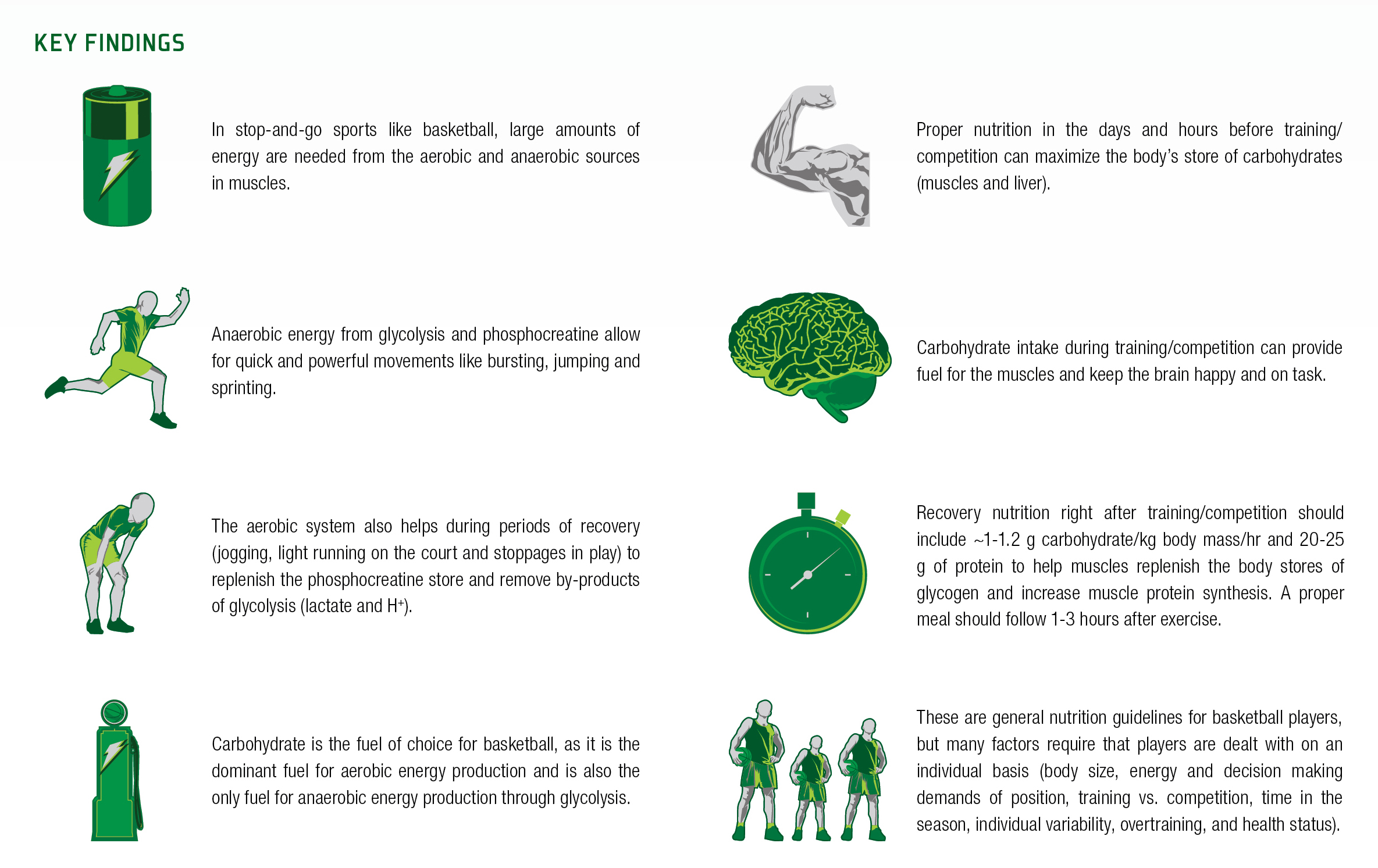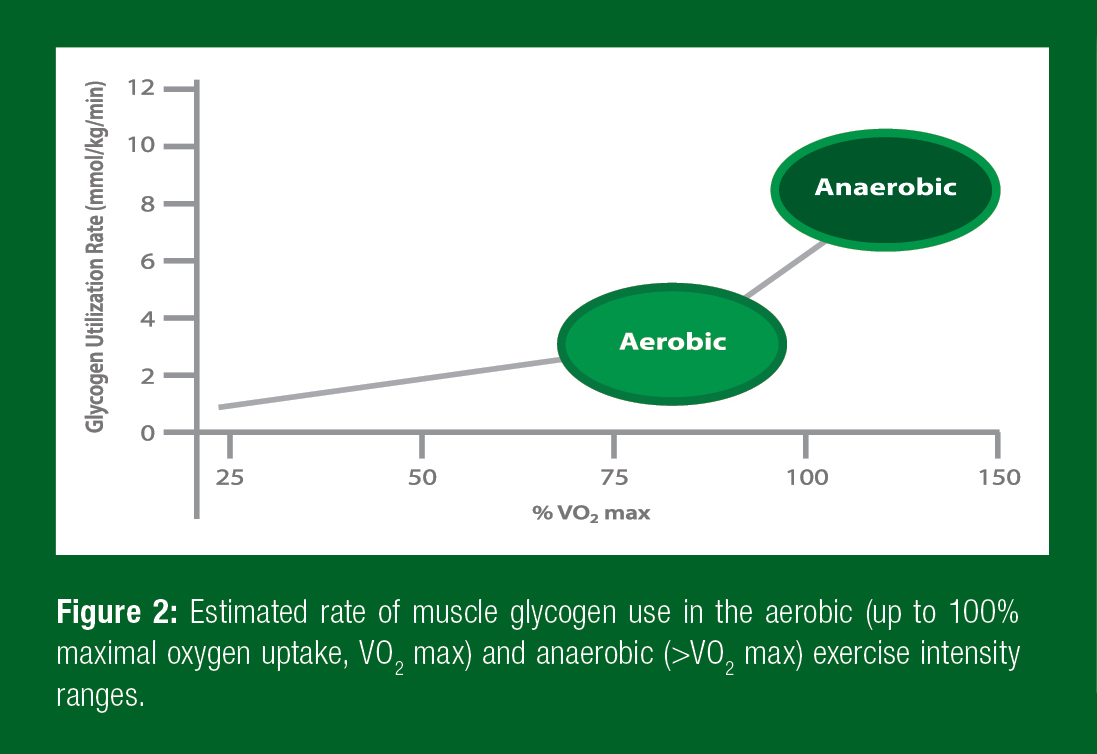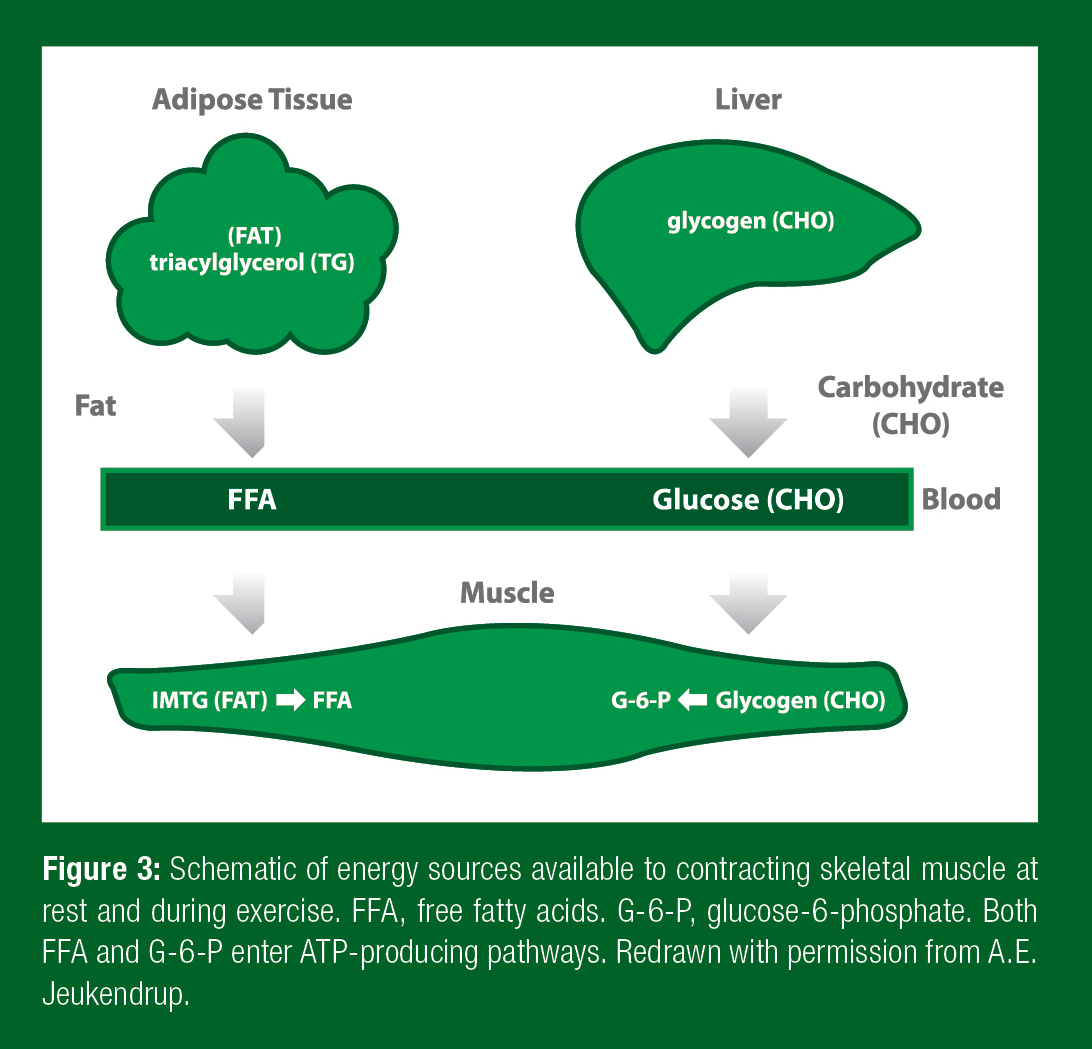INTRODUCTION
Basketball is a demanding stop-and-go sport where the energy demands of the player are constantly changing. Players could be completely stopped during time-outs, stoppages in play and foul shots, or could be walking or jogging on the court at low exercise intensities.
On the other hand, players may be hustling down the court or back on defense at a fast pace, or going full out in sprint-like fashion for a short period of time when driving the basket, attacking, or defending on a fast break. The skeletal muscles that allow athletes to move in the ways needed to effectively play basketball are most impressive in their ability to handle this spectrum of energy demands.
This SSE will examine how the muscles are able to provide the energy needed to play basketball at a high level and how nutrition plays an essential role in providing the fuels the muscles need to make sure energy provision is optimal in all situations and never runs out! The brain also benefits from proper nutrition and is heavily influenced by what an athlete eats and drinks. Therefore, nutritional guidelines and goals have been established for stop-and-go sports like basketball, which give the athletes, athletic trainers, nutritionists, coaches, and other team personnel general guidelines to follow, realizing that each player is an individual and will need one-on-one attention. There are previous reports that have examined nutrition for team sports including basketball.1,4,11
Experts in sports nutrition know that “diet significantly influences athletic performance” and that “all athletes should adapt specific nutritional strategies before, during and after training and competition to maximize their mental and physical performance”.5 Another way of saying this is, “a proper diet can’t make an average basketball player elite, but a poor diet can make an elite basketball player average!”
KEY FINDINGS

WHERE DO BASKETBALL PLAYERS GET THEIR ENERGY?
The contributions of the aerobic and anaerobic energy systems were discussed briefly in Chapter 2. However, a thorough understanding of these systems is crucial to appreciating the development of sports nutrition recommendations for basketball players and warrants further detail here.
Skeletal muscles continually produce a compound called adenosine triphosphate (ATP), which is the immediate source of energy for muscle contraction and ultimately movement. The muscles do this in two main ways. The first is referred to as oxidative or “aerobic” energy production, which occurs in the cellular compartments called mitochondria where oxygen is used to burn fat and carbohydrate for fuel. The second is via processes in the cell that do not need oxygen and fall under the category of “anaerobic” energy production. The two main sources of anaerobic ATP production are 1) the glycolytic pathway (called anaerobic glycolysis) with the use of carbohydrate as a fuel and 2) by using phosphocreatine (PCr) that is stored in the muscles.13
Aerobic energy production is the default energy production system and can provide ATP for long periods of time at quite a high rate. This system responds to exercise training and the capacity for ATP production can increase by 20%—50% in most people, depending on where they are starting from. The system can be compromised if the individual runs out of fuel, meaning not enough carbohydrate (CHO) or fat. This system also takes some time (~60—120 s) to fully turn on when beginning exercise or transitioning from low to higher exercise intensities. So, it could be argued that this system has some limitations when playing a stop-and-go game like basketball, as it is a game of transitions. That’s where the anaerobic energy systems come in to help.
The anaerobic systems (glycolysis and PCr) specialize in turning on very quickly (almost like a light switch) and producing ATP at high rates, higher than the aerobic system can handle. The latter is very important, as sprinting, jumping, and bursting activities in basketball require very high rates of energy production. The muscles need contributions from the aerobic system and both of the anaerobic systems to meet these needs. The down-sides to using the anaerobic systems are that they can run out quickly (PCr) or are associated with fatiguing by-products like increasing acidity (H+) in the muscles (glycolysis). When repeated bursts of activity are needed, like in a game of basketball, the depletion of CHO stores in the body can also limit the glycolytic system. Both anaerobic systems can be used repeatedly in a game of basketball, but the glycolytic system is generally more susceptible to fatigue due to increasing muscle acidity or CHO depletion. The PCr system has some advantages, as it is not slowed down by acidity and can be regenerated and recover in the muscle in as little as ~90 s of rest or light activity. During an intermittent game like basketball, PCr can be used over and over when periods of sprinting are followed by lighter activity and/or rest, and then more sprinting. On the other hand, the capacity of the glycolytic system can be improved by ~20% with exercise training, while the capacity of the PCr system does not change with training.
To summarize, the ability to play basketball at a high level requires both a high aerobic capacity and a high capacity to produce anaerobic ATP. The aerobic system produces continual amounts of oxygen-requiring energy, while the anaerobic system supplements during transitions to higher intensities and when athletes sprint, burst, or jump, where the energy need is too much for the aerobic system. In most basketball situations, other than stoppages in play, both systems are working together to produce the required energy. It is not a scenario where the aerobic system works alone or the anaerobic system works alone, as they work together in most instances.
There are some additional points that need to be made. The first is that CHO is the fuel of choice for the aerobic system during intense exercise. At 50% of a person’s maximal oxygen uptake (VO2 max), fat and CHO contribute about equally to fuel provision, but as the intensity climbs to ~80% VO2 max and beyond, CHO and specifically muscle glycogen becomes the dominant fuel (Figure 1). This has been shown in well-trained males and females.9,10 Carbohydrate is also the fuel of choice for sprinting, as the glycolytic pathway can only use CHO as a fuel and not fat or protein. So, if a basketball player is running the court at a high aerobic intensity and already using mainly CHO as a fuel, a sudden sprint will require more CHO, along with some PCr, to produce additional anaerobic energy. CHO provides a lot of energy when used for aerobic energy production (~36 mol ATP/mol CHO), but considerably less when used for anaerobic energy production (only 3 mol/mol CHO). So, sprinting, bursting, and jumping costs a lot of CHO in exchange for the ability to produce energy quickly on the court. This can be seen in (Figure 2), as muscle glycogen use rises exponentially when athletes work at power outputs above ~100% VO2max. Fortunately, athletes normally keep the bursts, jumps, and sprints short, but make sure they have ample CHO in the body before the practice or game and also ingest some CHO during the activity.


The second point is that the aerobic system also plays a large role in helping athletes quickly recover from intense activity. When PCr is degraded, it can quickly resynthesize when the activity slows to a low intensity or the athlete stops moving. The energy to recover the PCr comes from ATP produced aerobically such that the PCr store can be replenished in about 90 s. Importantly, the higher your aerobic capacity (VO2 max), the quicker the PCr replenishment occurs! The aerobic system also contributes to recovery in a second way by using lactate as a fuel in muscles when we move to a low intensity (jogging or walking the court) or stop moving. Removal of lactate from the muscles and blood helps remove the acidity that builds up when engaging in sprint and burst activities, and this helps lessen the feeling of fatigue. The bottom line here is that fit players recover more quickly than less- fit players. The third point is that genetic endowment plays a large role in an athlete’s capacity to produce aerobic and anaerobic energy and there is a large variation between individuals. However, energy provision is not the only determinant of success, as skill, ability to focus, determination, training, proper nutrition, etc., all play a role in the ultimate success of a basketball player.
THE IMPORTANCE OF CARBOHYDRATE AS A FUEL FOR BASKETBALL PLAYERS
Carbohydrate is the fuel of choice for stop-and-go sports like basketball. The members attending the IOC Consensus Conference on Sport Nutrition concluded, “In stop-and-go team sports, performance is limited by energy, and particularly carbohydrate intake”.5 Because of this important role, trained players store a large amount of carbohydrate (as glycogen) in the muscles they use to play the sport. There is also a large amount of glycogen stored in the liver in a well-fed player. The liver’s job is to release CHO in the form of glucose into the blood to maintain a blood concentration of about 5 mM at all times (Fig. 3). During exercise, the contracting muscles take up a lot of glucose from the blood, and the liver has to match this by replacing the used glucose. If unsuccessful, the person’s blood glucose drops, and they feel hypoglycemic, as the brain also relies mainly on glucose and is not happy when the level drops below normal. When exercise is intense and prolonged, the athlete can assist the liver in maintaining the blood glucose level by drinking a sports drink that has glucose or other forms of CHO. The ingested CHO quickly gets into the blood and can be used by the muscles, heart, and brain. There is also strong evidence that the ingestion of CHO during exercise stimulates the CHO receptors in the mouth to activate brain motor activity and reward centers, which may reduce the perception of fatigue and increase alertness and focus. 2

Mouth rinsing has also been shown to improve running performance.7,8 A similar situation exists with fat—trained people store a significant amount of fat directly in the muscles as intramuscular triacylglcyerol or triglyceride. Muscles can also take up fat in the form of free fatty acids from the blood, as it is released from adipose throughout the body (Fig. 3). However, fat only plays a significant role as a fuel at low to moderate aerobic exercise intensities and at rest, and is not a fuel for anaerobic energy production. Protein can also be used as an aerobic fuel, but this does not occur to any great extent in well-fed athletes. Protein plays major roles in assisting with CHO and fat energy metabolism during exercise and stimulating muscle protein synthesis during recovery from exercise. In summary, given the importance of CHO as a fuel for basketball players, it comes as no surprise that there are general guidelines for CHO intake in the days and hours leading up to a training session, or game, during the activity itself, and also following the training session, or game. Numerous studies using dietary recall techniques with basketball players suggest that athletes do not always reach these goals.3,6,12 The recovery phase after exercise is also the beginning of preparation for the next session as elite players are training or playing most days and often several times a day in tournaments.
SUMMARY
Playing basketball at a high level requires large amounts of energy provision by the skeletal muscles. Well-trained basketball players have high capacities to produce energy from both the aerobic and anaerobic energy systems. A high aerobic capacity (VO2 max) also speeds up recovery during the numerous periods of jogging or walking on the court and the stoppages in play during training and games. Carbohydrate is the fuel of choice for basketball players, as it serves as a fuel for both the aerobic and anaerobic energy producing systems. Fat is also used at lower intensities and during stoppages in play as an aerobic fuel. Clear guidelines are available for maximizing the availability of carbohydrate before, during, and after training and games. A small amount of protein ingestion following activity is also important to speed muscle recovery.

REFERENCES
1. Burke, L. (2007). Court and indoor team sports. In: Practical Sports Nutrition. Champaign, IL: Human Kinetics, pp. 221-239.
2. Chambers, E.S., M.W. Bridge, and D.A. Jones (2009). Carbohydrate sensing in the human mouth: effects on exercise performance and brain activity. J. Physiol. 587.8:1779-1794.
3. Grandjean, A. C. (1989). Macronutrient intake of US athletes compared with the general population and recommendations made for athletes. Am. J. Clin. Nutr. 49(5 Suppl):1070-1076.
4. Holway, F., and L.L. Spriet (2011). Sport-specific nutrition and practical strategies: Team sports. J. Sports Sci. 29:S115-S125.
5. Maughan, R.J., and S.M. Shirreffs (2011). IOC consensus conference and statement. J. Sports Sci. 29:S1-S4.
6. Nowak, R. K., K.S. Knudsen, and L.O. Schulz (1988). Body composition and nutrient intakes of college men and women basketball players. J. Am. Diet. Assoc. 88:575-578.
7. Rollo, I., C. Williams, N. Gant, and M. Nute (2008). The influence of carbohydrate mouth rinse on self-selected speeds during a 30-min treadmill run. Int. J. Sport Nutr. Exerc. Metab. 18:585-600.
8. Rollo, I., M. Cole, R. Miller, and C. Williams (2010). Influence of mouth rinsing a carbohydrate solution on 1-h running performance. Med Sci. Sports Exerc. 42:798-804.
9. Romijn, J.A., E.F. Coyle, L.S. Sidossis, A. Gastaldelli, J.F. Horowitz, E. Endert, and R.R. Wolfe (1993). Regulation of endogenous fat and carbohydrate metabolism in relation to exercise intensity and duration. Am. J. Physiol. 265:E380-E391.
10. Romijn, J.A., E.F. Coyle, L.S. Sidossis, J. Rosenblatt, and R.R. Wolfe (2000). Substrate metabolism during different exercise intensities in endurance-trained women. J. Appl. Physiol. 88:1707-1714.
11. Ryan, M. (2005). Nutrition for basketball. In: Performance Nutrition for Team Sports. Boulder, CO: Peak Sports Press, pp. 227-240.
12. Short, S. H., and W.R. Short (1983). Four-year study of university athletes’ dietary intake. J. Am. Diet. Assoc. 82:632-645.
13. Spriet, L. (2006). Anaerobic metabolism during exercise. In: Exercise Metabolism. M. Hargreaves and L. Spriet (eds). Champaighn, IL: Human Kinetics, pp. 7-27.